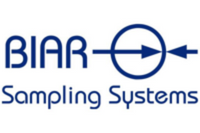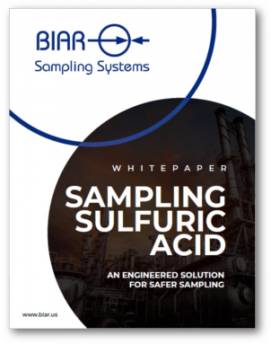Keeping Alkylation Units Running Efficiently
Sulfuric acid is a stable liquid that can be sampled in a bottle if vapors are vented properly to avoid potentially dangerous reactions with water, water vapor (humidity) and oxygen.
Why It’s Important to Take Sulfuric Acid Samples
- To monitor acid strength
- To prevent acid runaway in alkylation units that produce high octane gasoline.
What to Look for in the Sample
- Acid strength (if acid strength falls below 85%-87% H2SO4, conditions within the alkylation process become unfavorable, as olefins react with each other to form conjunct polymers (acid sludge), acid-soluble oil and red oil)
How to Safely Take Sulfuric Acid Samples
- BIAR Multi-Function PFA-lined inline sample valve with spring-to-close function
- Thread Adapter or bottle support
- Safety Cabinet (vented)
- Safety Plug (for secondary containment)
- Open-Top Jars or Bottles if ventilation is adequate or PFA-lined closed receptacles such as piston injectors.
BIAR PFA-lined sample valves are highly resistant to sulfuric acid corrosion and if installed directly on the process line, guarantee a representative sample every time. This is extremely important in an alkylation unit, as acid strength must be strictly monitored.
It also reduces waste and exposure risk, as no flushing or purging is necessary before collecting a sample. Because valves are designed to spring-to-close, they reduce the risk of accidental releases.
A vented safety cabinet around the sample point will reduce exposure risk even more. A BIAR sampling system for sulfuric acid can significantly reduce operating costs and allow Operations to run the unit in an efficient and economical manner.
Sulfuric Acid
1) Description
Name: ..............................................................................................Sulfuric Acid
Chemical Formula: .....................................................................H2SO4
CAS No: ..........................................................................................7664-93-9
Other Names: ...............................................................................Oil of vitriol, Hydrogen Sulphate
Uses: ...............................................................................................Industrial
Physical state: ..............................................................................Liquid
Color: ..............................................................................................Colorless to brown
Odor: ...............................................................................................Odorless
Boiling Point: ................................................................................290°C (554°F)
Melting Point: ...............................................................................10.56°C (51°F)
Flammability (solid, gas): ..........................................................N/A
Vapor Pressure:.............................................................................0.001 mm Hg
Similar Chemicals:........................................................................Oleum, Sulfur Trioxide (SO3)
2) Hazards
This material is considered hazardous by the OSHA Hazard Communication Standard (29 CFR 1910.1200).
H318: Causes serious eye damage.
H290: May be corrosive to metals.
Reactivity: Reacts violently with organic and inorganic materials and water.
Specific Hazards related to Sampling: When sampling Sulfuric Acid, it is important to protect the operator and surrounding areas from fumes. It is a stable liquid so it can be sampled in a bottle but vapors have to be properly vented to avoid dangerous reactions with humidity and oxygen.
_________

3) Sampling Facts
In an alkylation unit, isobutane is reacted with light olefins in the presence of a catalyst such as sulfuric acid to produce high octane gasoline. The alkylation reaction reduces the strength of the acid, and one of the primary goals of the unit is to maintain acid strength. This is to prevent an acid runaway situation. Lower acid strengths can lead to polymer formation when olefins react with each other.
Engineers are continuously challenged to reduce acid consumption, prevent acid runaways and produce a high quality product. A safe and reliable sampling system can be the difference Plants have to balance a fine line between running this process efficiently to maximize production and running the plant safely.
Once the sulfuric acid reaction occurs to make alkylate, the spent sulfuric acid can be regenerated back to its original high-quality sulfuric acid. It is vital that the sulfuric acid concentration is controlled and monitored so as to prevent an acid runaway situation at lower concentrations.
Acid strength. Acid concentration in the alkylation process must be strictly controlled to prevent runaway reactions from occurring. When acid strength falls below 85 - 87%, conditions are not favorable for the alkylation process, allowing olefins to react with each other and form polymers.
4) Most common Sample Receptacles
Open top jars or bottles are the most suited for sulfuric acid service if there is adequate ventilation or PFA lined closed receptacles such as a piston injector. Weak acid will react with stainless steel and cause severe corrosion and a buildup of sulphite compounds which can cause plugging and render some systems inoperable. While collecting the sample, the operator must be protected from spills and vapors and a safety box is preferable to an open sample station. Sample boxes protect the Operators from spills or overfilling and can be vented to prevent exposure to fumes. It is important to consider both the concentration of the acid and the temperature to ascertain the best material and ensure that no corrosion of the material of the sample system is possible.



